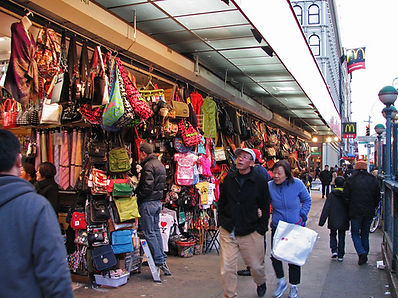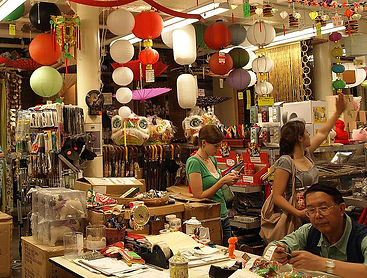Manhattan Chinatown
A Guide for Tourists
Shopping & the Economy in Manhattan's Chinatown

Shoppers on Canal Street in Manhattan's Chinatown

Introduction
According to history scholars Dan Wishnoff and Greg Umbach, the Manhattan Chinatown at first glance resists an “Orientalist” analysis in terms of traditional, exotic notions of Chinese culture portrayed in these urban landscapes. New York City’s Chinatown appears “authentic in its grittiness,” in comparison to the “Disney-esque streetscapes of so many American Chinatowns, with their pagoda-invoking rooflines, Chinese-inspired arches, and faux-Asian architectural ornamentation.”[i] However, the historians note that a closer examination of this Chinatown reveals that the community’s merchant elite have indeed worked hard to make this Chinatown alluring and intriguing to outsiders. Tourism, after all, is crucial to the survival of this area.
Many urban areas across North America have devoted significant economic resources to the development of tourism as a critical component of their local economies—the main focus of such tourism is often culture and cultural products.
Tourism has traditionally been an important source of business for most establishments in Manhattan’s Chinatown, including many restaurants and shops. Unfortunately, the economy of the Manhattan Chinatown suffered a severe blow after the attacks on September 11, 2001. Shopkeepers, who are dependent on tourists and clients who work in downtown Manhattan, have seen sales fall drastically. The economy of the area has not quite returned to pre-September 11th levels due to its proximity to Ground Zero, in contrast with the economic boom in New York City as a whole over the same time period.
An organized effort has been underway to improve the Manhattan Chinatown’s prospects. Jewelry shop owners, as well as those who operate clothing stores, souvenir shops and restaurants, have been the focus of a new business improvement district financed by building owners. The organization has supplied resources for public safety officers, new signage and marketing in an effort to make the neighborhood more attractive to visitors.[ii]
Tourism is on the upswing in Manhattan’s Chinatown, which has slowly but surely been livening up the shopping scene in the area.
Pearl River Mart, Manhattan Chinatown
Shopping: A Snapshot
“To a certain extent, if you go far enough into [the Manhattan] Chinatown, it’s like you’re in Shanghai.”
-- Neil Sood, Manhattan Chinatown resident, Summer 2013
For tourists and those not originally residing in the Manhattan Chinatown community, the shopping scene can be best understood in terms of several general points gleaned from Neil Sood’s interview with Max Lipscomb (See “Interview” tab). During the interview, Sood initially claimed that “everything was exotic” in the New York City Chinatown and went on to elaborate on the “massage parlors and fish markets…” noting that everything was handy for him because the shopping necessities were much less expensive than in other parts of New York City.
Max Lipscomb: Are the [shopkeepers and store owners] stuff pushy?
Neil Sood: That’s their way of living – either they sell [an item] or they don’t. If you go to a store, you should buy something, but if you linger or waste [the shopkeeper’s] time for more than 10 minutes, they’ll ask you to leave because it’s not worth their time. It’s not cut throat in that [the shopkeeper] really needs to sell you something, but obviously they’re doing their best to sell to you, whether they’re using the best sales tactics or not.
While shopkeepers are always eager to make a sale, the consumer can count on being treated with the utmost respect. Store owners are always around to offer guidance on their products!
Canal Street
Lonely Planet, another widely read guidebook series, has written a rave review of Canal Street in the Manhattan Chinatown. The review notes that while the hidden treasures of this Chinatown are found on winding and tiny side streets, Canal Street represents the heart of the area, leaving the visitor constantly excited but always on his or her toes. Stinky seafood markets, herb shops, storefront bakeries, and street vendors peddling eclectic and inexpensive trinkets represent just a portion of the colorful atmosphere that a tourist can encounter on Canal Street.[v]
Explore Chinatown: A Promotional Campaign
Explore Chinatown, a visitor’s promotion campaign on behalf of the Manhattan Chinatown, is intended to build awareness of Chinatown businesses in light of the lasting economic damage from the events on September 11, 2001. This campaign differs in their approach to describing the shopping in the Manhattan Chinatown, focusing much more on the high-class nature of much of the shopping in Chinatown as opposed to bargaining.
“Several charming and upscale shops in Chinatown offer classic lacquered and hardwood tables, cabinets and trunks with intricate inlays and carvings, stone Buddhas, rice-paper paintings, hand-painted scrolls, and embroidery on silk. Other shops are more like a good flea market, where you have no idea what high- or low-culture treasure you might discover.”[vi]
A Shopping Guide for Manhattan’s Chinatown
Frommer’s, a travel guidebook series founded in 1957, is one of the most well-respected brands offering practical advice and information on all manners of travel and tourism in thousands of different locations around the globe. The Frommer’s Guide to New York City includes a snapshot of Manhattan’s most “interesting” shopping scenes, as it provides information on shopping in the Manhattan Chinatown amidst a rundown of each of the major neighborhoods. Frommer’s calls attention to the fact that one cannot necessarily expect to find “the bargain of a lifetime” on the “crowded” streets of this Chinatown, yet with a little practice, finding a bargain is always doable! The guide has pinpointed the best “matrix” of Chinatown shops among the side streets south of Canal Street, between Mott Street and the Bowery.
Frommer’s writes that the jammed sidewalks, cramped stores, and vendors selling $1 eggrolls are enough to make the consumer question what country they find themselves in. This is Chinese authenticity at its finest!
“The fish and herbal markets along Canal, Mott, Mulberry, and Elizabeth streets are fun for their bustle and exotica—as well as for the handful of Italian joints still hanging on from the Little Italy days. Dispersed among them (especially along Canal), you’ll find a mind-boggling collection of knockoff sunglasses, handbags, fragrances, shoes, and watches. It can be a fun browse, but quality is questionable, and usually so are the sellers—and remember to bargain before busting out your wallet! (Also, skip the bootleg CDs, videos, and software—these are stolen goods, and you will be disappointed with the product.)”[iii]
The New York Times agrees, noting similarly that a shopper should “skip the bootleg CDs, videos and DVDs though [because you] will be disappointed.”[iv]
Centre Street and Grand Street
If you’re interested in housewares, spices, and local specialty foods, you should browse Centre Street and Grand Street. Photo opportunities here are plentiful if you don’t find the merchandise you’re looking for.
Ting's Gift Shop
Ting’s Gift Shop, located at 18 Doyer Street, is one of the oldest operating businesses in Chinatown, so make sure to stop by if you’re in the mood to shop for vibrant souvenirs to remember your experience in the Manhattan Chinatown. The shop has a “vintage pressed-tin ceiling,” and sells Chinese toys, kits, and lanterns. These goods are known to be top quality!
Neil B, from Brooklyn, New York reviewed Ting’s Gift Shop on Yelp. Check out his review!
“Ting's is one of the nicer gift shops in Manhattan's Chinatown. It is also one of the most established located at the corner of Doyers and Pell Streets in the heart of the original Chinatown. It is listed in several tour guides as the place to buy those finger traps that you put your fingers in and then can't pull them out but they carry a full line of Chinatown gifts at pretty much standard prices. What I like about the store is that it is clean and well organized. Also the quality of the gifts is better than at many of the other shops. And finally on weekends, when Elanor is the salesperson, you can buy from someone who speaks fluent English and does not play the "I don't understand" game after you purchase your gifts. So if you are shopping for Chinatown souvenirs, check out Ting's!”
Pearl River Mart
Finally, no visit to Chinatown is complete without visiting Pearl River Mart located at 477 Broadway. Souvenir shopping is prime here-one can find teapots, Buddha statues, kitchenware, and other affordable items.
Yelp reviews of Pearl River Mart are all glowing. Check one out!
“The Pearl River Mart is by far the greatest store in Chinatown. You can find everything from fabric, to beauty products, to tea sets. This place is a great shop if you need to decorate an apartment, get an interesting gift for someone, or just to look around. They have some really great finds in here, from mugs, lanterns, curtains, clothing, snacks, candy…the list goes on. It's pretty reasonable pricewise too and can basically fit anyone’s budget. It's one of the most fun stores in NYC and awesome prices.” (Jacqueline G, Manhattan, New York)
“Chinatown is hustle.
It is ritual. It is magic.”
Ten Ren Tea & Ginseng
Tea lovers will be at home in the Manhattan Chinatown – don’t miss Ten Ren Tea & Ginseng, located at 75 Mott Street. According to Frommer’s, “the lovely staff will help you select delectable teas and all the right brewing accessories.”
[i] Umbach, G., and D. Wishnoff. "Strategic Self-Orientalism: Urban Planning Policies and the Shaping of New York City's Chinatown, 1950-2005." Journal of Planning History 7.3 (2008): 214-38. Print, 215.
[ii] Wilson, Claire. "Chinatown Mobilizes to Enhance Its Outside Appeal." The New York Times 29 Mar. 2011: n. pag. Web.
[iii] "The Top Shopping Streets & Neighborhoods." In New York City. Frommer's, n.d. Web. 01 Mar. 2014.
[iv] Rozhon, Tracy. "Bargain Shopping." The New York Times. N.p., n.d. Web. 04 Mar. 2014.
[v] Lonely Planet Review. "Canal Street." Lonely Planet. N.p., n.d. Web. 02 Mar. 2014. .
[vi] "Arts and Antiques." Explore Chinatown NYC. N.p., n.d. Web. 01 Mar. 2014.